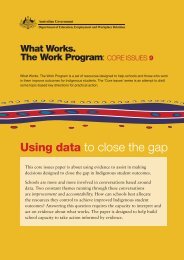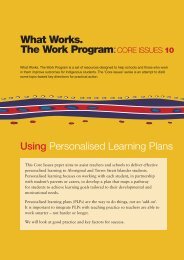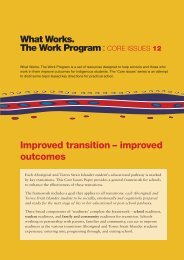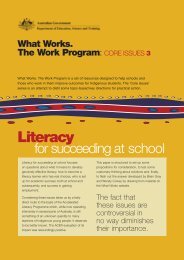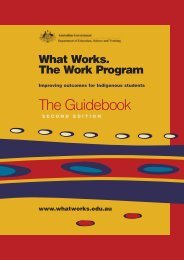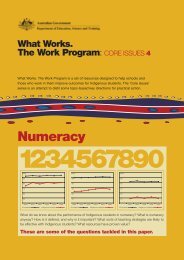Bound for Success Scope and Sequence Statements
Bound for Success Scope and Sequence Statements
Bound for Success Scope and Sequence Statements
- No tags were found...
Create successful ePaper yourself
Turn your PDF publications into a flip-book with our unique Google optimized e-Paper software.
MATHEMATICSPatterns <strong>and</strong> AlgebraConcept In Year 1the student:In Year 2the student:In Year 3the student:In Year 4the student:In Year 5the student:In Year 6the student:In Year 7the student:In Year 8the student:In Year 9the student:only 2 on the other side sowe need to put anotherperson on that side tomake it balanced”)(including 2 + 3 + 3 isgreater than 4 + 1 + 1) or‘unequal’ (including 6 – 4does not equal 10 – 5)equivalent, leaving it atthat)being told that the value ofa is 5 writes ‘3 + a = 4 + a– 1 = 12 – a – 2 = a – 3 +6’)to solve simple non-linearequations (e.g. finds thetime taken to travel 300km at an average speed of85 km/h, finds the value ofx <strong>for</strong> which 2x 2 + 3 = 53<strong>and</strong> determines theapproximate dimensions ofa rectangle with area100 cm 2 , width w <strong>and</strong>length 3 cm greater than itswidth)Patterns,sequences <strong>and</strong>generalisationsPatterns provide thepower to think beyondspecific cases togeneral ones• Recognises patterns intheir daily lives (e.g.sunrise <strong>and</strong> sunset, goingto school <strong>for</strong> 5 days <strong>and</strong>having 2 days off)• Identifies a repeatingpattern made of actions orsounds or objects <strong>and</strong>per<strong>for</strong>ms these in the orderidentified (e.g. hearssomeone stamp, click <strong>and</strong>clap, stamp, click, clap,<strong>and</strong> can repeat that pattern)• Recognises, continues <strong>and</strong>describes repeatingpatterns, identifying theelements of the patterncycle (e.g. says “there arethree colours in thepattern; red, blue <strong>and</strong>green <strong>and</strong> it goes red,blue, green, red, blue,green, red,…”)• Identifies <strong>and</strong> describespatterns as growing orrepeating <strong>and</strong> whatchanges from one elementof the pattern to the next(e.g. <strong>for</strong> the pattern, [ring],[ring, stamp, ring], [ring,stamp, ring, stamp, ring]says “there is another‘ring, stamp’ each time”)• Creates <strong>and</strong> continuespatterns <strong>and</strong> makes generalstatements of predictionabout what comes next(e.g. says ”the sixth onewill be green” <strong>and</strong>continues the pattern to seeif they are right)• Uses materials to representnumber <strong>and</strong> spatialpatterns <strong>for</strong> both growing<strong>and</strong> repeating patterns <strong>and</strong>describes what is changingfrom one element to thenext• Given the first 5 elementsof a pattern predicts thenext five <strong>and</strong> explains thebasis <strong>for</strong> their prediction,particularly <strong>for</strong> growingpatterns, <strong>and</strong> continues thepattern showing theirprediction to prove theyare right; Shows what iscommon (or generalisable)in a repeating pattern byusing a different <strong>for</strong>m (e.g.shows the colour patterngreen, blue, green, blueusing actions such as clap,jump, clap, jump by firstrecognising there are twoelements in the pattern <strong>and</strong>they repeat alternately)• Uses materials to representnumber <strong>and</strong> spatialpatterns (e.g. uses countersto model <strong>and</strong> identifytriangular <strong>and</strong> squarenumbers, <strong>and</strong> matchsticksto make growth patterns)• Underst<strong>and</strong>s therelationship between anelement in a pattern cycle<strong>and</strong> its position in thatcycle <strong>and</strong> can predict whatcomes next in the pattern(e.g. <strong>for</strong> the patternF E F E F E1 2 3 4 5 6 7they are able to see that ‘E’is in the ‘even’ positions<strong>and</strong> can predict that the16th position will be even<strong>and</strong> hence ‘E’ if the patterncontinues• Identifies <strong>and</strong> continuesnumber patterns <strong>and</strong>describes what is changingin words (e.g. continues 3,6, 9, 12…. <strong>and</strong> says “thepattern is ‘add three’ eachtime”, <strong>and</strong> continues 2, 5,10, 17…saying “thedifference between the firsttwo numbers is 3, the nexttwo 5, <strong>and</strong> the next two 7:this makes a new numberpattern where thedifference is two eachtime”); Writes the pointsgenerated as ordered pairs[e.g. (1,3),(2, 6), (3, 9) …<strong>and</strong> (1,2), (2,5), (3,10) ]• Identifies number patternsthat are ‘linear’ byexamining the differencepattern <strong>and</strong> recognisingthat linear patterns have aconstant difference termbetween the elements ofthe pattern, <strong>and</strong> that whenthese number patterns aregraphed in the firstquadrant the points <strong>for</strong>m astraight line [e.g. (1,3),(2,6),(3, 9) … will <strong>for</strong>m alinear pattern while (1,2),(2,5), (3,10) will not] <strong>and</strong>plots these points by h<strong>and</strong><strong>and</strong> with a graphingcalculator• Exp<strong>and</strong>s numbers <strong>and</strong>variables represented byindex powers (e.g. 3 4 = 3 x3 x 3 x 3 <strong>and</strong> y 3 = y x y xy); Generalises numberpatterns <strong>and</strong> describeswhat they have noticed aschanging in the pattern in ageneral sense (e.g. onexamining the pattern2,4,8,16,… can describethe pattern as “eachnumber in the pattern isdoubled to get the nextterm”, <strong>for</strong> the sequence )• Explores <strong>and</strong> establisheslinear equivalences [e.g.2(4x + 8) = 4(2x + 4) = 8(x+ 2) ] <strong>and</strong> explores <strong>and</strong>establishes simple nonlinearequivalences (e.g.generalises numberpatterns including 27 2 =(20 + 7) 2 = 20 2 + 2 x 20 x7 + 7 2 = 400 + 280 + 49 =72920 +7400 140 20140 49 +7• Uses a diagram to show (a+ 2) x (a + 3) = a 2 + 5a +6 <strong>and</strong> (2x) 2 = 4x 4 ;Generalises from numberexamples including 4 3 x 4 2= 4 5 <strong>and</strong> 4 5 ÷ 4 2 = 4 3 toshow that x 3 x 2 = x 5 <strong>and</strong>x 5 ÷ x 2 = x 3• Identifies where letters areused in mathematics torepresent words (e.g. ‘3c’represents ‘three cents’ <strong>and</strong>‘20 m’ represents ‘twentymetres’)• Identifies where letters areused in <strong>for</strong>mulae torepresent differentquantities (e.g. l = 2 x wcan be used to representthe <strong>for</strong>mula “length equalstwo times the width” <strong>and</strong>that the two quantities‘length’ <strong>and</strong> ‘width’ canvary depending on the sizeof the quadrilateral) <strong>and</strong>can tell the differencebetween two statementsusing letters: one wherethe letter represents a word(e.g. 5c) <strong>and</strong> one where theletter represents a quantitythat varies• Uses a letter/variable torepresent a variablequantity <strong>and</strong> explains whythe letter does not st<strong>and</strong> <strong>for</strong>the word but <strong>for</strong> a number(e.g. given the statement‘Mary is three years olderthan John’ is representedby M = J + 3, can explainwhy ‘M’ does notrepresent ‘Mary’ but infact represents Mary’s age- a number, <strong>and</strong> in the<strong>for</strong>mula P = 2 x l + 2 x w,l represents the numbermeasurement of the length<strong>and</strong> not the word ‘length’,reading this as “Perimeter• Underst<strong>and</strong>s concatenation(i.e. that ‘3x’ represents ‘3lots of whatever number xrepresents’ since x is avariable quantity; if ‘c’represents ‘the number ofcats’ then ‘4c’ does notrepresent four cats but‘four lots of the number ofcats’) <strong>and</strong> can complete atable such as the followingshowing differentrepresentations; Usesconcatenation to exp<strong>and</strong>4(2x + 8) by reading thisas “four lots of, two lots ofwhatever number xrepresents, plus 8”;• Re-arranges linear <strong>and</strong>some simple non-linearalgebraic expressions (e.g.p = 3q – 2 to obtain q =(p-2)/3; given A = πr 2 <strong>and</strong>a specific value of A, findsthe corresponding value ofr <strong>and</strong> obtains the generalcase r = √A/π noting that rmust be positive in therelated practical context;Uses words <strong>and</strong> symbols torepresent variables <strong>and</strong>constants <strong>and</strong> interpretsalgebraic expressions <strong>for</strong>relationships developed incontext; Constructsexpressions that involve<strong>Bound</strong> <strong>for</strong> <strong>Success</strong> <strong>Scope</strong> <strong>and</strong> <strong>Sequence</strong> <strong>Statements</strong> V2 Page 44 Working Document Semester One 2007





